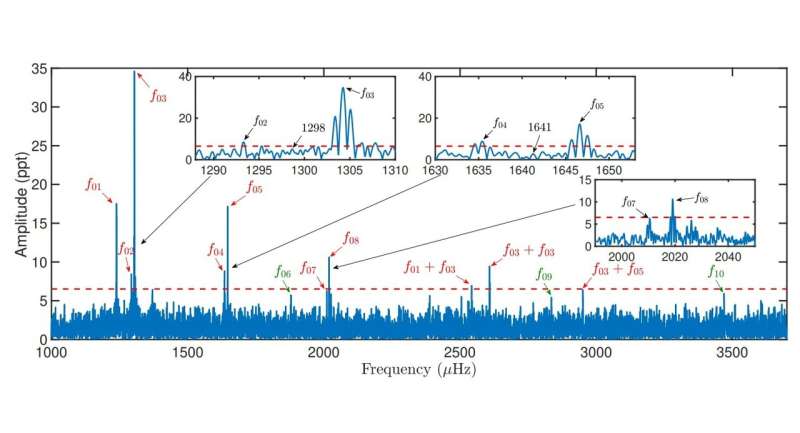February 5, 2024 report
This article has been reviewed according to Science X's editorial process and policies. Editors have highlighted the following attributes while ensuring the content's credibility:
fact-checked
preprint
trusted source
proofread
Astronomers inspect a peculiar pulsating variable white dwarf

Astronomers have conducted spectroscopic and photometric observations of a peculiar pulsating variable white dwarf known as TMTS J17184064+2524314. Results of the observational campaign, published January 26 on the preprint server arXiv, provide essential information regarding the properties and behavior of this object.
White dwarfs (WDs) are stellar cores left behind after a star has exhausted its nuclear fuel. Due to their high gravity, they are known to have atmospheres of either pure hydrogen or pure helium. However, a small fraction of WDs shows traces of heavier elements.
In pulsating white dwarfs, luminosity varies due to non-radial gravity wave pulsations within these objects. One subtype of pulsating WDs is known as DAVs, or ZZ Ceti stars—these are white dwarfs of spectral type DA, having only hydrogen absorption lines in their spectra.
At a distance of about 228.5 light years away, TMTS J17184064+2524314 (or J1718 for short) is a DA white dwarf with a mass of approximately 0.63 solar masses and an effective temperature of 11,361 K. In 2020, J1718 was classified as one of many new ZZ Ceti WDs, with a main pulsation period of 731 seconds.
Now, a team of astronomers led by Jincheng Guo of Beijing Planetarium in China has combed through the data obtained mainly by the Tsinghua University-Ma Huateng Telescope for Survey (TMTS) and NASA's Transiting Exoplanet Survey Satellite (TESS), in order to learn more about the properties of this peculiar variable star.
By performing a thorough asterosesimological analysis, Guo's team managed to derive accurate parameters for J1718. All in all, they identified 10 pulsating periods and three combination periods of this variable.
The rotation period of J1718 was calculated to be approximately 25.12 hours. The age of the white dwarf was found to be about 510 million years, while its effective temperature was measured to be a little higher than previously thought—at a level of 11,640 K.
The mass of J1718 was estimated to be about 0.75 solar masses, therefore the star turned out to be more massive than previously suggested. The study also found that the carbon and oxygen abundances in the core of J1718 turned out to be approximately 0.43 and 0.57, respectively.
According to the authors of the paper, the obtained results confirm that J1718 is a relatively massive DAV with a slightly thick hydrogen atmosphere.
"From the asteroseismological result, it can be learned that J1718 is a relatively massive pulsating WD with a slightly thick hydrogen atmosphere. The final results are consistent with the parameters derived from spectral fitting of our follow-up spectrum," the researchers concluded.
More information: Jincheng Guo et al, Variable white dwarfs in TMTS: Asteroseismological analysis of a ZZ Ceti star, TMTS J17184064+2524314, arXiv (2024). DOI: 10.48550/arxiv.2401.14692
Journal information: arXiv
© 2024 Science X Network





















